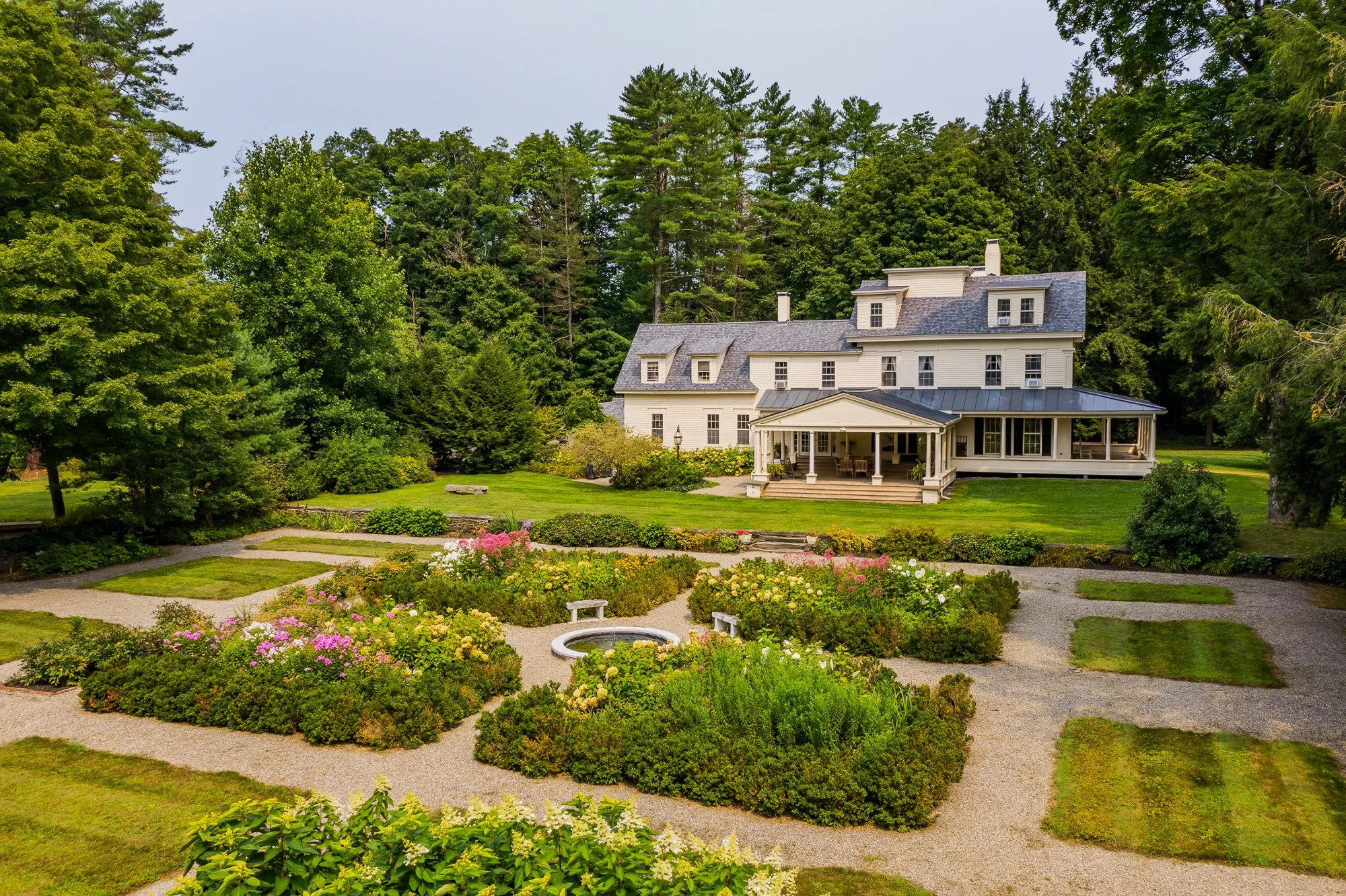Mastlands
112 Route 12A | Cornish NH
Closed at $1,460,000
Property Overview
Welcome to Mastlands, a beautiful home within the Cornish Art Colony, rich in history and brimming with meticulously restored original details. Built in 1858, this colonial farmhouse has hosted elegant gatherings of the early 1900s, led by Augustus Saint-Gaudens, attracting prominent artists and dignitaries. It has also been a sanctuary for garden enthusiasts captivated by Rose Nichols' sunken garden, an inspiring summer retreat for families in the mid-1900s, the Cornish Colony Museum, and most recently, a cherished family residence.
Named "Mastlands" for the tall, straight Eastern white pines on the property that once served as masts for the King's sailing ships, this home is set back from the road, framed by trees, expansive farmland, and exquisite gardens. From the moment you enter, it's clear that this home is meant to be shared with friends and family. The grand rooms, high ceilings, intricate moldings, and a beautiful farmhouse kitchen overlooking the porch and gardens are just a few of the features that draw you from room to room. Original doors, locks, and period glass have been carefully restored, adding to the home's charm. The home also boasts five fireplaces, all of which have been restored to wood-burning or gas-burning.
The most exceptional space on the main floor is the renovated ballroom wing, an addition orchestrated by Rose Nichols. Inspired by a European château being dismantled at the time, Nichols had parts salvaged and shipped to be reassembled on the property. This room transports you to another era while offering modern comforts. With its dark wood paneling, large curved windows, and massive wood-burning fireplace, this room invites you to host guests, celebrate holidays, read by the fire, or perhaps enjoy a cocktail while playing chess—it truly exudes a "stay awhile" atmosphere.
Above the ballroom is the primary bedroom wing, complete with a large dressing room, porch, wood burining fireplace, and en suite bath. Two additional stately bedrooms and a bath occupy the second floor, while a third level with a fourth bedroom captures the nostalgic essence of historic summer homes, with wood paneling reminiscent of a lakeside retreat.
A spacious one-bedroom apartment located over the western wing of the home offers versatile living options. It’s perfect as a separate living space for family members, friends, or a caretaker, or it can be used as an income-generating rental. The apartment is fully equipped with a kitchen, a small breakfast nook, a living room, and a 3/4 bath with a separate laundry. Accessible through the garage with its own private entrance, it maintains independence from the main residence. Alternatively, if more space is needed for additional upstairs bedrooms, the apartment can easily be reintegrated into the main living area.
As if the interior weren’t charming enough, the home also features a spacious columned portico off the kitchen, serving as a summer al fresco dining room with views of the gardens. A wrap-around porch further enhances the architectural beauty and offers additional spaces for outdoor relaxation and enjoyment.
Mastlands is perfect for those who appreciate a home steeped in history and have a passion for continuing the stewardship and enhancement of such historic properties.
























































The Gardens & Grounds






















This property has a rich history as the summer home of Dr. Arthur Nichols, a respected holistic doctor from Boston, and his wife, Elizabeth Homer, a distant relative of the renowned artist Winslow Homer. The Nichols family, which included their three daughters—Rose, Marian, and Margaret—cherished this estate deeply. Rose Nichols, inspired by her uncle Augustus Saint-Gaudens and the esteemed architect and painter Charles Platt, designed the estate’s walled garden, aptly named "Mastlands." Rose later pursued her passion for landscape architecture, studying in Europe and the U.S., and went on to design approximately 70 gardens throughout her career, while also authoring several books on pleasure gardens.
Although Rose's original planting plans have not survived, the garden garnered widespread acclaim during its prime. Visitors spoke fondly of its beauty, with one remarking, "Rose's garden was the most delightful of all." Over time, however, the gardens fell into neglect after the property left the Nichols family's hands. Fortunately, a dedicated restoration effort began in 2014-2015 by the current owners, breathing new life into the gardens while honoring Rose’s original vision.
The current owners have invested tireless effort and thoughtful care into restoring the gardens to their former glory. The gardens now burst with vibrant colors throughout the season, thanks to a seasonal irrigation system that ensures their vitality. The three water fountains on the property have been lovingly resurrected, including the centerpiece—a custom rough-cut marble fountain that is illuminated at night, creating a magical ambiance even after dusk.
At the far end of the walled sunken garden, "Pine Tree Alley" offers a peaceful, shaded walk leading to a bench and sundial, evoking a sense of nostalgia for a bygone era. Additionally, raised vegetable gardens, discreetly tucked away from the main quadrants, provide ample space for growing seasonal produce. Perennial plantings frame every corner of the home, making this estate a true gardener's delight.
Beyond the gardens' beauty, this property spans 24 acres of mostly open farmland, currently cultivated by a local farmer. Among the features of this expansive estate is a tennis court, originally built for Margaret Nichols, who had a passion for the sport. The court currently needs restoration, but it offers the opportunity to be revitalized as a tennis court or transformed into a versatile sport court.
Two small sheds near the house store garden supplies and house a whole-house generator. The property’s location offers excellent opportunities for outdoor activities, with access to a nearby Class 4 road that intersects with the picturesque River Road, perfect for scenic walks. The paths around the cornfields provide additional routes for leisurely strolls.
For those seeking tranquility, a small fire pit and various secluded spots throughout the property offer peaceful retreats.
Summary Details
Original Colonial Farmhouse Built-In 1858
5 Bedrooms + 4 Baths
5,518 Finished SQ.FT. (approximate)
Taxes (2024): $20,142
Attached 2-Car Garage
Heat: Force Hot Air (1st Floor) & Baseboard Hot Water (2nd & 3rd Floor)
Main Floor Central A/C
Fuel: Oil
Five Fireplaces (Wood & Gas)
Foundation: Stone | Siding: Clapboard | Roof: Standing Seam, Asphalt Shingle & Rubber Membrane
Private Water & Septic
Internet & Tasco Alarm System
Whole House Generator
24.17 Acres
Tennis Court and Barn (*both need restoration)
Extensive Gardens & Mature Landscaping
About Cornish
Cornish, New Hampshire, established in 1763, was originally known as Mast Camp, a key shipping point for the tall masts floated down the river by English settlers. Incorporated in 1765 by Colonial Governor Benning Wentworth, it was named after Sir Samuel Cornish, a distinguished vice-admiral of the Royal Navy.
In the late 19th century, Cornish became a celebrated summer retreat for artists and writers. The renowned sculptor Augustus Saint-Gaudens first visited Cornish in 1885, seeking an escape from the summer heat of New York City. His presence attracted other artists, transforming the area into one of the first artist colonies in the United States. The Cornish Colony flourished, drawing painters, sculptors, decorators, illustrators, architects, landscape designers, novelists, journalists, playwrights, poets, critics, essayists, composers, musicians, theatrical performers, and patrons of the arts, primarily from New York City and Boston.
The creative energy of the colony was inspired by the natural beauty of the river valley and Mt. Ascutney, as well as the unique camaraderie among the artists. Notable figures such as painter Henry O. Walker, architect Charles Platt, illustrator Maxfield Parrish, and art critic Kenyon Cox were among those who established homes in Cornish during the 1890s. Even President Woodrow Wilson spent his summers at Winston Churchill's "Harlakenden House," which served as his summer White House from 1913 to 1915.
Gardens played a significant role in the artistic expression of the colony, with extensive gardens created by Thomas Dewing, Stephen Parrish, and landscape designers like Charles Platt, Ellen Shipman, and Rose Nichols. Saint-Gaudens' home, "Aspet," with its beautifully landscaped grounds, became a focal point of Cornish and now serves as the Saint-Gaudens National Historical Park. The site offers summer lawn concerts, theater presentations, and tours of the studios where the famous sculptor and his students worked.
Today, Cornish residents continue to enjoy the town's charming scenery, nestled among hills, valleys, peaceful farms, and riverbanks along the Connecticut River. The historic Cornish–Windsor Covered Bridge, once the longest covered bridge in the U.S., spans the Connecticut River between Cornish and Windsor, Vermont. Outdoor enthusiasts can explore the Cornish Town Forest, with its extensive trail network and breathtaking views from Wellmans Hill.
The area is also known for its local farms, such as Edgewater Farm and Riverview Farm, which offer seasonal produce, pick-your-own strawberries and blueberries, and events like "dinners in the orchard." Mac's Maple, located along the riverbank, is famous for its maple soft-serve ice cream and dairy products. In the fall, the landscape is dotted with yellow corn and bright orange pumpkins, adding to the region's picturesque charm.
Cornish is conveniently located near Kimball Union Academy, a private preparatory school, and is just minutes away from Lebanon, Hanover, Dartmouth College, and the Dartmouth-Hitchcock Medical Center, making it a perfect blend of history, culture, and natural beauty.

